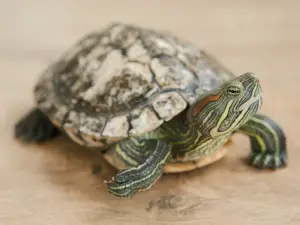
Turtle shells are known to be quite tough and strong, discovering that your turtle’s shell is squishy when you push down on it will be concerning to any turtle keeper
This article looks into why your turtle’s shell may be squishy
Why is my turtle’s shell squishy?
The shell is vital for protecting the turtle against predators that may want to bite it, it is also vital because it protects the turtle’s delicate organs. If it doesn’t perform well then the reptile will be at risk of suffering internal injuries
Here is why your turtle’s shell may be squishy:
Young turtle:
Young turtles are still growing and maturing so their shells won’t be as hard as adult turtle shells will be.
The shell will especially be soft at the ends of the shell, these areas will be quite flexible and this may make them feel squishy
Most turtles won’t have a fully developed shell until they have been alive for months or even years.
What to do:
It’s normal for the shells of these turtles to be soft and more on the squishy side, you don’t have to worry, as long as the shell isn’t overly soft then your pet should be fine.
Just make sure that your little pet is eating a diet that has sufficient amounts of nutrients and minerals for the animal to grow well and the shell to harden over time.
In addition to an appropriate diet, make sure that your pet basks under UV light and has a cuttlebone in its enclosure. Remove the hard cuttlebone backing before giving it to the turtle
Metabolic bone didease
If your turtle isn’t young anymore, but its shell feels quite squishy and soft then the animal may be suffering from a condition called metabolic bone disease.
This condition develops when there is a lack of vitamin D3, and or calcium, in the animal’s diet and body, the result of this is soft and weak bones.
The shell is a bone in the animal’s body and will thus be affected if the other bones in the body are soft.
Not only will the bones and the shell become soft but shell deformities may develop in turtles who have this condition. Your turtle’s muscles may also develop difficulty contracting if it suffers from this illness.
What to do:
This condition, if not too advanced, can be remedied by increasing calcium and vitamin D in your pet’s diet and by making sure that the animal basks under its UV light.
If your pet’s condition is advanced then you’d need to get the reptile to a reptile specialist vet for an examination and treatment.
Infection:
If your pet’s shell has an infection then this can cause a weakening of the shell and this can cause the shell to become soft and squishy.
What to do:
Taking your pet to the vet is the recommended solution in this case. The vet will examine the animal, diagnose the reptile, and suggest a treatment plan that will hopefully get the shell strong again.
If there are no reptile specialist vets in your area then you can request that your local vet take a conference call with a reptile specialist vet for guided care.
If you enjoyed this article then you may also be interested in other turtle/tortoise related articles. Here are some articles that you may be interested in: Why Is My Turtle’s Shell Turning Blue?, Why Does My Turtle’s Shell Look Cracked?, Why Is My Turtle’s Shell Breaking?, Why Is My Turtle’s Shell Shiny?, Why Is My Turtle’s Shell Turning Green?, Why Is My Turtle’s Shell Dented?, Why Is My Turtle’s Shell Getting Darker, Why Is My Turtles Shell Caving In?, Why Is My Baby Turtle Not Growing?

